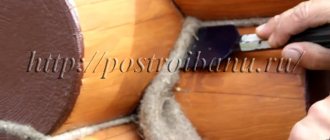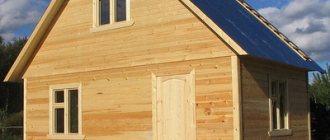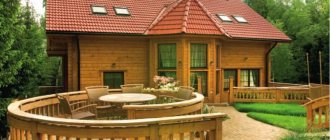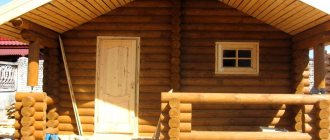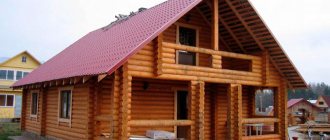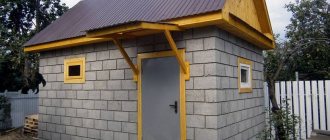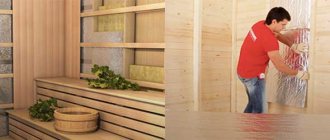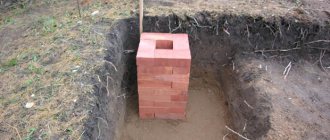| Material, type of work: | Price per 1 m2: | |
| Glued laminated timber | From 200 rub/m2 (depending on the size of the timber) | |
| Rounded log | From 250 rub/m2 (depending on the diameter of the log) | |
| Log house | From 350 rub/m2 (depending on the degree of contamination and log diameter) | |
| Sanding the ends of logs | 350 rub/m.p. | |
| Polishing | From 60 rub. |
Sanding a frame made of timber or logs is a mandatory process for finishing the walls of wooden houses. This procedure allows you to remove all irregularities and various defects from the surface. It is performed manually using a special electric tool. Sanding a beam or log is a rather labor-intensive process that requires special knowledge and skills.
Recognized advantages and disadvantages of a log house
Once upon a time, people built houses exclusively from wood, decorated the walls with fragrant flowers, and the floors with herbs, because they believed that Mother Nature would appreciate their efforts, rewarding them with priceless gifts - good health, inexhaustible wealth, fiery love. Today, of course, no one believes in this, but, nevertheless, log houses are in great demand, as they are known for a number of advantages:
Wooden design
- environmental friendliness;
- security;
- durability;
- wear resistance;
- resistance to deformation;
- low thermal conductivity;
- frost resistance;
- excellent sound insulation;
- natural ventilation;
- ease of care;
- healing aroma;
- amazing appearance;
- favorable energy.
A wooden structure also has disadvantages - these are:
- change in natural shade;
- biological activity;
- flammability.
The disadvantages are quite serious, however, proper processing of raw materials will not allow them to overshadow your life in such a beautiful structure.
When to grind
Opinions are divided on whether to sand the walls of the log house immediately or wait for it to completely shrink and dry. Some believe that waiting until the log house shrinks and the wood shrinks is too long, because the process is quite long, depending on many external factors such as:
- Log cutting season;
- Log manufacturing technologies;
- Type of wood, its density and humidity;
- Type of insulation used between the crowns;
- Climatic data of the region.
In addition, during this period the wood can become infected with fungus and change its color.
Others believe that this matter should not be rushed. The darkened color of the wood will disappear after sanding, and the fungus can be easily removed using biological impregnation. It is necessary to fully comply with all the necessary conditions for an effective and high-quality result.
To do this, the roof must be covered, the structure must completely shrink, but most importantly, the moisture content of the wood should not exceed 20%.
Despite the divergence of opinions, experts still recommend making your choice in favor of the second option. Premature processing and painting of damp walls can result in big troubles for the owner.
In addition, it is not necessary to curtail construction work to wait for the log house to be ready for grinding. During this period, you can work on plumbing and electrical wiring, laying floors, ceilings, and installing windows and doors.
Advantages of log sanding
Sanding timber is a rather labor-intensive and time-consuming process, but, as they say, “If you’re afraid of the wolf, don’t go into the forest.” Before you start work, you need to realize the importance of the matter so that the mosquito does not undermine your nose.
Sanding logs:
- perfectly levels the surface;
- ideally cleans raw materials;
- helps maintain the original shade;
- provides high adhesion to paints and varnishes;
- reduces the cost of finishing materials;
- allows antiseptic impregnation to be evenly distributed over the surface without the formation of pigment spots;
- prevents wood aging;
- protects the material from rotting, mold and insects;
- increases resistance to the negative effects of climatic, thermal, mechanical, and chemical factors.
The result of the work is walls, as in advertising photographs of presentable construction companies.
Advice from LLC "AZBUKI LESA"
- The log house needs to be sanded when the moisture content of the log is no more than 15%.
It is this moisture content of the log that is considered optimal for painting and varnishing and is one of the indicators of the end of the main shrinkage. The frame needs to be coated with compounds within 3 days, so it is not advisable to order sanding of a wooden house earlier. - It is recommended to sand the walls in the log house after finishing the roofing work.
Otherwise, you will have to either very carefully cover the roof or repeat the cleaning. - After cleaning, the logs are first coated with a primer, then protective agents, glazes and oil or wax are used.
By the way, flaxseed oil has a pronounced antiseptic effect. - A good effect is obtained by applying an antiseptic
using the airless spray method. - The ends must be sanded manually;
the abrasive method does not allow these areas to be properly processed.
Turnkey finishing of wooden houses is our specialization! We will offer you the best option depending on the desired result and your budget!
Some nuances at work
The technology for polishing a log frame is not as scary as it is made out to be. The main thing is to stock up on quality tools, materials and patience. In addition, you should pay attention to some nuances. That is, the work is performed after:
- installing the roof to prevent rain from soaking the walls;
- drying the wood, otherwise the abrasive grinding wheel (wheel) will clog and the wood will become “ruffled” (the nominal drying period is about 12 months from the date of construction of the structure);
- treating the material with a bleaching antiseptic, since the log house darkens during the drying process.
In addition, if the frame is not treated with paint or antiseptic within 7 days after sanding, the surface will darken and the entire work will have to be done again. Here is an article about how to paint a log bathhouse.
It is also not recommended to delay the finishing, otherwise you can forget about a uniform, attractive shade. And yet, the work is done before installing windows, ceiling and floor coverings. I think you understand why: there will be dust - “mother, don’t worry.” So, let's go.
Photo
Well, you say, there are some unevenness on the tree - can’t you just paint them over? Can. But because of the unevenness, you will need more paint and varnish. And antiseptics too. By the way, antiseptics will be absorbed worse, and the varnish or paint will not adhere so well. It seems to us that there are enough arguments for polishing. Oh, and one more thing: when sanding, you remove the top layer of wood, making its pattern clearer and more beautiful, which adds aesthetics to the walls.
How to sand a house made of timber? This work cannot be called difficult, but you will need a lot of patience, since grinding is monotonous work.
Required set of tools
We arm ourselves with a tool for polishing the log house. During the work we will need:
Flap attachment for grinder Multifunctional tool
- grinder (angle grinder);
- belt sander or eccentric;
- grinding attachments (discs);
- bars with an emery base;
- chisel for processing hard-to-reach places;
- industrial vacuum cleaner;
- glasses;
- respirator;
- gloves;
- protective substances - fire retardants, antiseptics, acrylates, etc.;
- brushes or spray gun for applying products intended for wood processing;
- sealant for wood, warm seam (if there are cracks or such ideas);
- decorating paint or special oil impregnations (if desired).
Please note that for a structure made of timber, the ideal option is a belt sander (or eccentric), and for walls made of rounded logs, the ideal solution is a small grinder with special petal attachments.
Technology for polishing the walls of a wooden house
We found out what is needed for grinding. All that remains is to figure out the question: “How to do this?” We will also find out the possibilities of independently implementing the problem.
Speaking about technology, I would like to immediately list the stages, but in this case it is difficult to talk about it. The problem is that the “starting” material can be very different:
- an old darkened log house, the roughness of which has almost smoothed out over time;
- a new hand-cut house or bathhouse after shrinkage, which has wane, bast, remains of knots, uneven ends;
- a rounded log of a round shape, but with the presence of grooves from the cutter;
- house made of profiled or laminated dry timber with flat surfaces after the machine.
Let's look at everything separately.
Sanding log walls
Features of sanding the walls of a log house made from hand-cut logs
This is the most complex situation and therefore requires more detailed explanations. With a certain degree of convention, three stages of work can be distinguished.
Sanded and non-polished ends of the frame
Rough processing of chopped logs is carried out with a grinder with a petal attachment or sandpaper with grain 40. It is necessary in three specific situations:
1. Elimination of large irregularities in the new log house. In this case, the angularities and unevenness of the knots are removed from the log. With short movements of 20–30 cm, the grinding wheel of the grinder should “walk” along the log. The work is carried out evenly; you cannot stop in one place to avoid the formation of a depression or blackening of the wood from overheating. A section on one side of one log 20–30 cm long will take 2–3 minutes, and a 6-meter log, respectively, up to 1 hour.
Problem: “How long will it take to rough grind a 6 by 6 meter bathhouse with 12 rims of logs?” Answer: “I don’t have that much time!”
The end of the log at the roughing stage is processed with a peeling wheel-bowl. This is how the ledges on the saw cuts are leveled.
2. Rough sanding will be required in a situation where it is necessary to paint a house that has stood untreated and unpainted for several years. Wood quickly darkens in the sun, small cracks and many burrs form. There is even more work here, since you need to not only level it, but also remove the entire darkened layer, and this is up to 2 mm.
3. A similar situation can arise with a painted house. For example, the house was painted with topcoat, which began to peel over time. You paint it with glaze so that the texture is visible. In this situation, you will have to completely remove the entire layer.
After roughing, the surface of the log is smoothed, but after sanding with 40-grain sandpaper, many scratches remain. In addition, a large amount of unsanded bast may remain if there was a scrape treatment. At this stage, take a skin with a grain of 60 or 80: if you take 60, the process will go faster, the skin will not become heavily clogged with dust, the consumption of the skin will be less, but scratches may remain. With 80 grit there will be no scratches, but it becomes heavily clogged with dust, and the process takes even more time.
The end is also processed, but 60 grain is enough here.
After this, the main stage of grinding the outside of the log can be completed, but it is advisable to go through the inside one more time, but with 120 grit.
With chopped logs, processing with sandpaper of 60 and 80 grains can be carried out with a grinder, but if it can be used to reduce the speed to 5000, it will be better. The risk of wood burning will be reduced and it will be easier to control the percentage of bast removal if you want to maintain a slight spotting. Sanding with 120-grit sandpaper is best done with an eccentric sander.
Final sanding is carried out after the first layer of paint, when the smoothed pile rises and becomes rougher from the paint. Here it is necessary to apply the minimum grain size (from 200 to 400).
Features of grinding rounded (calibrated) logs
A calibrated log is obtained after processing on a machine. It is obtained in the shape of a cylinder, which is why it is also called rounded. The roughing here has already been carried out by a machine; the surface is quite smooth, but barely noticeable transverse rings may remain from the cutter. They must be removed by sanding and preparing the surface for painting, making it smoother.
For this, sandpaper with 80-grit abrasive is used, but it is no longer advisable to use a grinder, since it can only worsen the appearance of the log. For work, it is more reasonable to use an eccentric grinder or rotary polisher with a frequency of 200 to 2000 revolutions. This will make the log perfectly smooth.
If you put a bowl brush with 60-80 abrasive in a rotary machine, then the defects from the cutter will be sanded, but the surface will not be smooth, since soft summer layers will be removed faster. An emphasized wood texture will appear. This is brushing a wooden surface.
Sanding timber walls
Profiled and laminated timber also undergo machine processing, only their surface is even smoother. In fact, it is already ready for processing, but no machine will give an ideal surface: the knife is dull or other problems can always arise. Therefore, minimal sanding is required. For this, it is better to use sandpaper with a grain size of 100 - 120 (on the outside, 80 may be enough, but you need to make sure that it does not make the surface worse).
It is better to use an eccentric or vibration grinder.
Sandblasting by professionals
Jet grinding of a log house requires strict adherence to technology, so it should be performed only by specialists. Professional grinders have undergone special training, are fluent in the technological process of sandblasting, and have the necessary work skills.
Qualified specialists of our company will perform abrasive jet sanding of a house of any size. If you want to inexpensively polish a log house, contact us. We guarantee exclusive quality of work and minimal deadlines.
You will find all our coordinates in the “Contacts” section. There you can write us a message or contact us in another convenient way.
What is sandblasting
The abrasive-jet method of grinding logs involves exposing a wooden surface to an abrasive consisting of a specially prepared sand mixture of certain types of sand. The mixture is supplied under high pressure and, together with the air flow, produces gentle and accurate wood processing.
Sanding by the jet method involves the use of special industrial equipment - a sandblasting machine. Therefore, work may only be carried out by qualified personnel who have undergone appropriate training.
Sandblasting of wood is carried out without contact. The device is located at some distance from the treated area, which completely eliminates damage to the surface.
